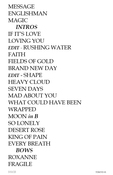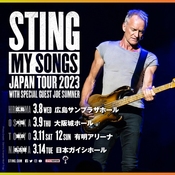
A balanced performance of reimagined classics and recent works...
A stage packed with Sting's latest work. The Tokyo premiere of Sting's "MY SONGS JAPAN TOUR 2023," his first Japan tour in about three and a half years, took place at Ariake Arena on March 11th. As with his previous Japan tour, it was expected that he would perform his album "My Songs" (2019), which featured updated versions of his signature songs, but he also released a new album, "The Bridge," in 2021. Artists always aspire to deliver their current creations. The result was a truly delicious musical fare, a balanced mix of classics and recent works. The opening act was Sting's son, Joe Sumner. This talented musician, who first rose to prominence as the bassist for Fiction Plane in the early 2000s, is now in his mid-40s. Interspersed with fluent Japanese MCing, he delivered a spirited performance accompanied by guitar and vocals, as if to "make every single person in this packed audience my fan." The performance, which included his signature track "Hope," which was also used in President Biden's campaign, evoked a deep reverence for American roots music, further raising expectations for his upcoming solo album. After the venue warmed up, Sting's stage finally began. Even knowing that his masterful melodies and lyrics would be surging at us like a raging storm, experiencing them live was overwhelming. Experience the intensity of the songs that shine through the years, be captivated by Sting's fresh vocals and warm thumb-plucked bass sound, who he himself wrote and performed, be amazed by the tight band ensemble, and sense the progressive spirit of the refined arrangements... As you become engrossed and engage your ears, eyes, and sensibilities, your notion of time will fly away.
The accompanying band is a select group of musicians, led by Dominic Miller (guitar), who has become what you might call Sting's right-hand man, along with Kevon Webster (keyboards), Zach Jones (drums), Gene Noble (choir), Melissa Muzik (choir), and Shane Sager (harmonica). I was puzzled by the lack of a vocal microphone stand at the front of the stage, but as soon as the performance began and Sting strutted from stage left carrying his trademark Original Precision Bass (the peeling paint on the body suggested it was a different bass from the 1957 model he'd used for years), and began singing "Message in a Bottle," it all made sense. He wasn't using a stand microphone, but a headset microphone (he had an in-ear monitor on his left ear. After reviewing various live videos, I discovered he'd switched to this microphone in 2022). I was also impressed by the way he used this microphone. Not only was his voice sharp yet warm, but it was so clear you could almost hear his breathing, yet his "s" weren't too sharp, and there was no hint of any nasal noise. Sting walked from side to side of the stage, delivering a crisp bass line with occasional pulls, exciting the audience and drawing them into the music. He truly had the arena in his hands with just this one song. As "Englishman in New York" begins, the cheers from the audience erupt even louder. Sting sings the melody with great ease, mixing in some stylish falsetto, but to my ears, the bass line jumps out at me in equal proportion to the vocals. This is because I love the relaxed rhythm and deep tone that his bass lines create in songs that incorporate reggae elements like this. His approach, where he sometimes stretches out the note values to the fullest to change the space of the ensemble, also shows his extraordinary sense. I've seen various comments about him, such as "he practices using jazz bassist Ray Brown's method book" and "before a show, he warms up his fingers by playing Jaco Pastorius's "Teen Town"," but the feel that permeates "Englishman in New York" and "Walking on the Moon" is truly mystical. In "King of Pain," he plays the A-melody in a position closer to the bridge, and from the section beginning with "There's a little black sun," he moves his picking position closer to the highest fret on the neck to play with a softer tone. Throughout the live performance, he alternated between using both thumb picking and two fingers in many songs, and in songs like "Every Little Thing She Does is Magic" and "Rushing Water," he added a touch of elegance to the songs by switching to two fingers in the choruses. Other memorable performances included the bass riff in "Heavy Cloud No Rain," which features a unique, rustic pull that's somewhere between thumb picking and slap playing, the five-beat phrases in "Seven Days" that were in perfect sync with the drums and made us wonder, "Can he play this while singing?", and his powerful playing in "So Lonely," where he uses downward thumbing to send the strings into a frenzy. He performed "If It's Love," "Loving You," and "Rushing Water" consecutively from his latest original album, "The Bridge," and also performed "What Could Have Been," which he provided for the 2021 Netflix anime "Arcane," with footage from the show playing in the background. It was clear to see that this master melody maker is as alive as ever.
During the encore, he captivated the audience with his skilful rhythm changes in "Roxanne" and his choppy bass playing in the reggae zone midway through. Though he only picked up guitar for the final song, "Fragile," Sting played a single precision bass throughout the 20 songs up to that point. Combined with the excellent acoustics, it was an exquisite night where we were able to fully appreciate the charms of both vocals and bass. We look forward to his soon-to-be return to Japan.
(c) bassmagazine.jp by Kazunori Harada
Sting: Fresh Emotions, New Brilliance, and Flavour...
Sting returned to Japan for the first time in three and a half years. Needless to say, these long years coincided with the period when the world was at the mercy of the COVID-19 pandemic. Anticipation for a "Sting Live" was at an all-time high, and with news of excitement fuelling the excitement from fans in Hiroshima and Osaka, Sting's first Tokyo performance took place on March 11th. The venue was Ariake Arena, which had only recently begun full-scale event use last summer.
The opening act was Sting's son, Joe Sumner. He sang original songs like "Jelly Bean" and "Hope" with just a guitar and entertained the audience with a delightful MC in Japanese. After a short interval, he finally appeared with the Sting Band.
As the band, led by Dominic Miller, took their positions, Sting stepped out from the left side of the stage, clutching his beloved Precision Bass. He was wearing a slightly undersized T-shirt and slim-fitting black pants. While it might not be accurate to describe him as well-toned, he had absolutely no excess fat, making it hard to believe he was 71 years old.
The opening number was "Message of Solitude." With the weighty yet sharp rhythm delivered by East Coast drummer Zach Jones, who joined the band last year, using a simple one-tom set, the band breathed new life into this 44-year-old classic. Sting now uses a headset microphone (meaning he doesn't have to face the mic stand), allowing him to move freely around the stage and shift his gaze in sync with the rhythm and lyrics as he sings. This dynamic image also seems to contribute greatly to the new impression of the Sting Band.
Following "Englishman in New York" and "Magic," featuring harmonica player Shane Sager, Sting casually launched into the intro to "If It's Love," then played "Loving You" and "Rushing Water," eliciting a laugh with a comment about learning the Japanese word "kuchibue." He then delved into a section highlighting his recent album, "The Bridge." In a sense, "The Bridge" was a work created by taking advantage of the loss of work opportunities caused by the COVID-19 pandemic, and as a record that conveys the current state of Sting as a musician, he likely wanted to showcase it in detail.
Following "Lose My Faith in You" and "Fields of Gold," featuring Dominic Miller's beautiful gut-string guitar solo, Sting called Shane to the centre for "Brand New Day," featuring Stevie Wonder's memorable harmonica performance. After this dynamic and powerful performance, Dominic switched back to gut-string guitar for the lyrical "Shape of My Heart." They then moved on to "Heavy Ground, No Rain," featuring Melissa Muzik on the chorus, followed by "Seven Days" and "Mad About You," before the atmosphere changed completely.
The stage set for this tour was very simple, essentially making effective use of lighting to place the emphasis on the sound itself. At one point, footage from the Netflix animated series "Arcane" was projected onto a horizontal screen, and Sting delivered a thorough rendition of "What Could Have Been," his song for the anime, accompanied by Kevon Webster's heavy keyboard-driven sound. Then, maintaining this atmosphere, the song shifted to "Around Your Finger," a song from The Police era, with a candle-lit image reminiscent of the music video appearing in the background. It was truly a beautiful performance.
The concert was nearing its end. "Walking on the Moon" and "So Lonely," two Police songs with strong reggae rhythms and imagery, were performed almost entirely in medley form. The moment the song transitioned, led by Sting's bass, was breathtakingly vivid.
Then, in the second half of the medley, "So Lonely," the band sang Bob Marley's classic "No Woman, No Cry." However, instead of the familiar title, the band emphasized the line, "Good friends we have, Good friends we've lost, Along the way." It was a truly Sting-like way to convey a message.
Next, Sting transported the packed audience to the deserts of North Africa with "Desert Rose," then concluded the concert with a medley of Police classics, including "King of Pain" and "I Want to Watch You." (Joe Sumner also contributed vocals to these two songs.)
For the encore, he began with "Roxanne," in which he and the audience became one. Then, armed with a gut-string acoustic guitar, Sting declared, "That's it for tonight," before launching into "Fragile." The captivating beauty of the guitar in this song always moves me with a fresh feeling, but this time it seemed to have taken on a new brilliance and flavour.
The central theme of "My Songs," the title of both the album and the tour, is reimagine—rethinking and re-examining. It's a creative act only Sting, keenly aware of the universality of his work, can muster. It's one he continues to enthusiastically pursue every day, even on tour.
But above all else, it seemed the focus this time was on sharing his joy and enjoyment with his fans at being able to reunite after such a long hiatus. On top of that, it was a two-hour performance brimming with Sting's signature style, showcasing his future direction and potential with tracks like "What Could Have Been" and three from The Bridge. To borrow the delightful Japanese phrase Joe Sumner spoken of at the start of the show, it was truly "manpuku." Audience members of all ages likely headed home with similar feelings.
(c) barks.jp




